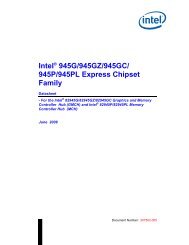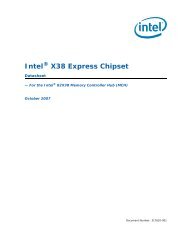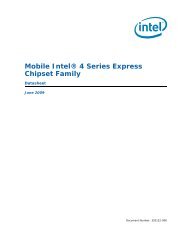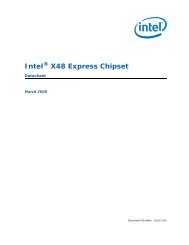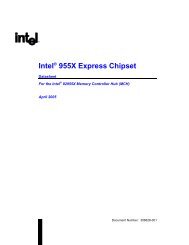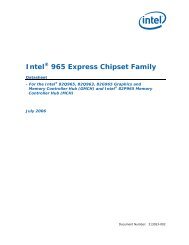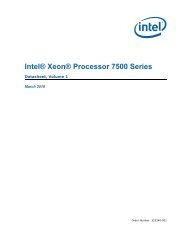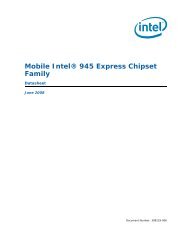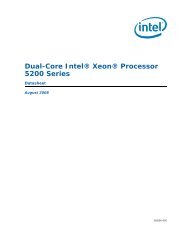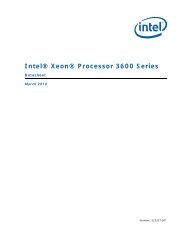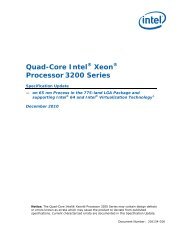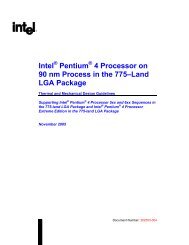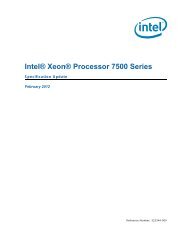- Page 1 and 2: Intel ® G35 Express Chipset Datash
- Page 3 and 4: Contents 1 Introduction ...........
- Page 5 and 6: 5.1.17 DMIBAR—Root Complex Regist
- Page 7 and 8: 6.1.28 SS—Subsystem ID and Subsys
- Page 9 and 10: 8.2.25 PMCAPID—Mirror of Fun 0 Po
- Page 11 and 12: Figures Tables Figure 1-1. Intel ®
- Page 13 and 14: Revision History Revision Number De
- Page 15 and 16: Intel ® 82G35 GMCH Features • Pr
- Page 17 and 18: Datasheet 17
- Page 19 and 20: Introduction Figure 1-1. Intel ® G
- Page 21 and 22: Introduction Term Description Intel
- Page 23: Introduction 1.3 GMCH Overview The
- Page 27 and 28: Introduction Capabilities of the SD
- Page 29 and 30: Introduction Datasheet 29
- Page 31 and 32: Signal Description 2.1 Host Interfa
- Page 33 and 34: Signal Description Signal Name Type
- Page 35 and 36: Signal Description 2.3 DDR2 DRAM Ch
- Page 37 and 38: Signal Description Signal Name Type
- Page 39 and 40: Signal Description 2.9 Controller L
- Page 41 and 42: Signal Description 2.10.1 SDVO/PCI
- Page 43 and 44: Signal Description Datasheet 43
- Page 45 and 46: System Address Map • Device 2, Fu
- Page 47 and 48: System Address Map Figure 3-2. DOS
- Page 49 and 50: System Address Map Table 3-1. Expan
- Page 51 and 52: System Address Map Figure 3-3. Main
- Page 53 and 54: System Address Map Figure 3-4. PCI
- Page 55 and 56: System Address Map 3.4 Main Memory
- Page 57 and 58: System Address Map 3.6 PCI Express*
- Page 59 and 60: System Address Map 3.8.1 SMM Space
- Page 61 and 62: System Address Map 3.8.5 SMM Space
- Page 63 and 64: System Address Map 3.10.1 PCI Expre
- Page 65 and 66: System Address Map Datasheet 65
- Page 67 and 68: GMCH Register Description 4.1 Regis
- Page 69 and 70: GMCH Register Description The GMCH
- Page 71 and 72: GMCH Register Description Just the
- Page 73 and 74: GMCH Register Description 4.4.2 Bri
- Page 75 and 76:
GMCH Register Description Bit Acces
- Page 77 and 78:
GMCH Register Description Datasheet
- Page 79 and 80:
DRAM Controller Registers (D0:F0) A
- Page 81 and 82:
DRAM Controller Registers (D0:F0) 5
- Page 83 and 84:
DRAM Controller Registers (D0:F0) B
- Page 85 and 86:
DRAM Controller Registers (D0:F0) 5
- Page 87 and 88:
DRAM Controller Registers (D0:F0) 5
- Page 89 and 90:
DRAM Controller Registers (D0:F0) 5
- Page 91 and 92:
DRAM Controller Registers (D0:F0) B
- Page 93 and 94:
DRAM Controller Registers (D0:F0) 5
- Page 95 and 96:
DRAM Controller Registers (D0:F0) 5
- Page 97 and 98:
DRAM Controller Registers (D0:F0) 5
- Page 99 and 100:
DRAM Controller Registers (D0:F0) 5
- Page 101 and 102:
DRAM Controller Registers (D0:F0) 5
- Page 103 and 104:
DRAM Controller Registers (D0:F0) 5
- Page 105 and 106:
DRAM Controller Registers (D0:F0) B
- Page 107 and 108:
DRAM Controller Registers (D0:F0) 5
- Page 109 and 110:
DRAM Controller Registers (D0:F0) 5
- Page 111 and 112:
DRAM Controller Registers (D0:F0) 5
- Page 113 and 114:
DRAM Controller Registers (D0:F0) 5
- Page 115 and 116:
DRAM Controller Registers (D0:F0) A
- Page 117 and 118:
DRAM Controller Registers (D0:F0) 5
- Page 119 and 120:
DRAM Controller Registers (D0:F0) 5
- Page 121 and 122:
DRAM Controller Registers (D0:F0) 5
- Page 123 and 124:
DRAM Controller Registers (D0:F0) 5
- Page 125 and 126:
DRAM Controller Registers (D0:F0) 5
- Page 127 and 128:
DRAM Controller Registers (D0:F0) B
- Page 129 and 130:
DRAM Controller Registers (D0:F0) 5
- Page 131 and 132:
DRAM Controller Registers (D0:F0) 5
- Page 133 and 134:
DRAM Controller Registers (D0:F0) 5
- Page 135 and 136:
DRAM Controller Registers (D0:F0) 5
- Page 137 and 138:
DRAM Controller Registers (D0:F0) B
- Page 139 and 140:
DRAM Controller Registers (D0:F0) B
- Page 141 and 142:
DRAM Controller Registers (D0:F0) 5
- Page 143 and 144:
DRAM Controller Registers (D0:F0) 5
- Page 145 and 146:
DRAM Controller Registers (D0:F0) B
- Page 147 and 148:
DRAM Controller Registers (D0:F0) 5
- Page 149 and 150:
DRAM Controller Registers (D0:F0) B
- Page 151 and 152:
DRAM Controller Registers (D0:F0) 5
- Page 153 and 154:
DRAM Controller Registers (D0:F0) 5
- Page 155 and 156:
DRAM Controller Registers (D0:F0) T
- Page 157 and 158:
DRAM Controller Registers (D0:F0) 5
- Page 159 and 160:
DRAM Controller Registers (D0:F0) 5
- Page 161 and 162:
DRAM Controller Registers (D0:F0) 5
- Page 163 and 164:
PCI Express* Registers (D1:F0) Addr
- Page 165 and 166:
PCI Express* Registers (D1:F0) 6.1
- Page 167 and 168:
PCI Express* Registers (D1:F0) Bit
- Page 169 and 170:
PCI Express* Registers (D1:F0) Bit
- Page 171 and 172:
PCI Express* Registers (D1:F0) 6.1.
- Page 173 and 174:
PCI Express* Registers (D1:F0) 6.1.
- Page 175 and 176:
PCI Express* Registers (D1:F0) 6.1.
- Page 177 and 178:
PCI Express* Registers (D1:F0) 6.1.
- Page 179 and 180:
PCI Express* Registers (D1:F0) 6.1.
- Page 181 and 182:
PCI Express* Registers (D1:F0) 6.1.
- Page 183 and 184:
PCI Express* Registers (D1:F0) 6.1.
- Page 185 and 186:
PCI Express* Registers (D1:F0) 6.1.
- Page 187 and 188:
PCI Express* Registers (D1:F0) Bit
- Page 189 and 190:
PCI Express* Registers (D1:F0) 6.1.
- Page 191 and 192:
PCI Express* Registers (D1:F0) 6.1.
- Page 193 and 194:
PCI Express* Registers (D1:F0) Bit
- Page 195 and 196:
PCI Express* Registers (D1:F0) Bit
- Page 197 and 198:
PCI Express* Registers (D1:F0) 6.1.
- Page 199 and 200:
PCI Express* Registers (D1:F0) Bit
- Page 201 and 202:
PCI Express* Registers (D1:F0) 6.1.
- Page 203 and 204:
PCI Express* Registers (D1:F0) Bit
- Page 205 and 206:
PCI Express* Registers (D1:F0) 6.1.
- Page 207 and 208:
PCI Express* Registers (D1:F0) 6.1.
- Page 209 and 210:
PCI Express* Registers (D1:F0) 6.1.
- Page 211 and 212:
PCI Express* Registers (D1:F0) 6.1.
- Page 213 and 214:
PCI Express* Registers (D1:F0) Data
- Page 215 and 216:
Direct Memory Interface (DMI) Regis
- Page 217 and 218:
Direct Memory Interface (DMI) Regis
- Page 219 and 220:
Direct Memory Interface (DMI) Regis
- Page 221 and 222:
Direct Memory Interface (DMI) Regis
- Page 223 and 224:
Direct Memory Interface (DMI) Regis
- Page 225 and 226:
Integrated Graphics Device Register
- Page 227 and 228:
Integrated Graphics Device Register
- Page 229 and 230:
Integrated Graphics Device Register
- Page 231 and 232:
Integrated Graphics Device Register
- Page 233 and 234:
Integrated Graphics Device Register
- Page 235 and 236:
Integrated Graphics Device Register
- Page 237 and 238:
Integrated Graphics Device Register
- Page 239 and 240:
Integrated Graphics Device Register
- Page 241 and 242:
Integrated Graphics Device Register
- Page 243 and 244:
Integrated Graphics Device Register
- Page 245 and 246:
Integrated Graphics Device Register
- Page 247 and 248:
Integrated Graphics Device Register
- Page 249 and 250:
Integrated Graphics Device Register
- Page 251 and 252:
Integrated Graphics Device Register
- Page 253 and 254:
Integrated Graphics Device Register
- Page 255 and 256:
Integrated Graphics Device Register
- Page 257 and 258:
Integrated Graphics Device Register
- Page 259 and 260:
Integrated Graphics Device Register
- Page 261 and 262:
Integrated Graphics Device Register
- Page 263 and 264:
Integrated Graphics Device Register
- Page 265 and 266:
Integrated Graphics Device Register
- Page 267 and 268:
Integrated Graphics Device Register
- Page 269 and 270:
Manageability Engine (ME) Registers
- Page 271 and 272:
Manageability Engine (ME) Registers
- Page 273 and 274:
Manageability Engine (ME) Registers
- Page 275 and 276:
Manageability Engine (ME) Registers
- Page 277 and 278:
Manageability Engine (ME) Registers
- Page 279 and 280:
Manageability Engine (ME) Registers
- Page 281 and 282:
Manageability Engine (ME) Registers
- Page 283 and 284:
Functional Description 10.1.4 FSB D
- Page 285 and 286:
Functional Description populate or
- Page 287 and 288:
Functional Description 512-Mb techn
- Page 289 and 290:
Functional Description Table 10-4.
- Page 291 and 292:
Functional Description 10.2.4 DRAM
- Page 293 and 294:
Functional Description Figure 10-2.
- Page 295 and 296:
Functional Description Figure 10-3.
- Page 297 and 298:
Functional Description 10.4.1.2 Vid
- Page 299 and 300:
Functional Description 10.5.1 Analo
- Page 301 and 302:
Functional Description 10.5.2.1.2 T
- Page 303 and 304:
Functional Description 10.5.3 Multi
- Page 305 and 306:
Functional Description 10.7.3 Progr
- Page 307 and 308:
Functional Description 10.8 Clockin
- Page 309 and 310:
Functional Description Datasheet 30
- Page 311 and 312:
Electrical Characteristics Symbol P
- Page 313 and 314:
Electrical Characteristics 11.2 Sig
- Page 315 and 316:
Electrical Characteristics Signal T
- Page 317 and 318:
Electrical Characteristics 11.3.2 G
- Page 319 and 320:
Electrical Characteristics Symbol P
- Page 321 and 322:
Electrical Characteristics 11.3.3 R
- Page 323 and 324:
Ballout and Package Information Fig
- Page 325 and 326:
Ballout and Package Information Fig
- Page 327 and 328:
Ballout and Package Information Tab
- Page 329 and 330:
Ballout and Package Information Tab
- Page 331 and 332:
Ballout and Package Information Tab
- Page 333 and 334:
Ballout and Package Information Tab
- Page 335 and 336:
Ballout and Package Information Tab
- Page 337 and 338:
12.2 Package The GMCH package measu
- Page 339 and 340:
Testability 13 Testability In the G
- Page 341 and 342:
Testability Table 137-1. XOR Chain
- Page 343 and 344:
Testability 13.3 XOR Chains Table 1
- Page 345 and 346:
Testability Table 13-6. XOR Chain 4
- Page 347 and 348:
Testability Table 13-9. XOR Chain 7
- Page 349 and 350:
Testability Table 13-13. XOR Chain
- Page 351:
Testability 13.4 PADs Excluded from



